|
When I was a child, the scariest place on earth was the desert region of the American Southwest. I'd never been there, at least not in person, but childhood fascination with American 50s science fiction films had convinced me that just about anything could be lying in wait for those foolish enough to wander off the dusty main road. Two films in particular haunted my formative years, Gordon Douglas's 1954 Them! and Jack Arnold's 1953 It Came From Outer Space. They left me in no doubt that the New Mexico deserts were home to monstrous ants, and that skulking away in the Arizona Badlands were slug-like, cycloptic blobs that could shape-shift into humans and replace my loved ones. Creepiest of all, these deserts had a noise, a kind of high-pitched, unearthly theremin whine. I loved them to bits. Being scared by such films remains one of the fondest memories I have of my childhood.
The really cool thing is that when I got to revisit these same films as an adult, many of them were every bit as great as I remember. And once I started learning the names of directors, it didn't take long to realise that the genre had its own master in the shape of the aforementioned Jack Arnold. As a young man, Arnold had fallen in love with science fiction and leapt at the chance to direct genre movies. In his enthusiasm he became responsible for a handful of favourites. It Came From Outer Space was followed by The Creature From the Black Lagoon, Revenge of the Creature (1955), Tarantula (1955), four episodes of the TV show Science Fiction Theatre (all 1955) and the dyed-in-the-wool 1957 classic, The Incredible Shrinking Man. Although Arnold directed from other people's scripts, he did co-write the story for Tarantula, plus one other film that he didn't direct and that precious few people I've met seem to have seen, the 1957 The Monolith Monsters. And it's really rather special.
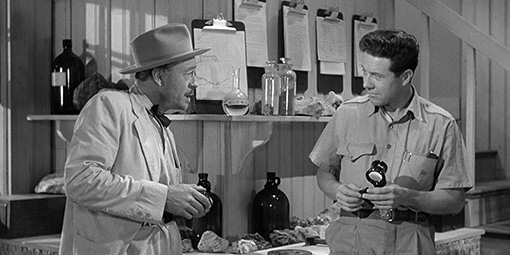
The story is the standard 50s alien invasion tale with an intriguing twist. A meteor crashes in the desert outside of the small town of San Angelo in California, shattering into a multitude of small black crystalline fragments. The following morning, geologist Ben Gilbert (Phil Harvey) finds one of the rocks and takes it back to his office, where water spills on it and prompts it to grow. When head of the San Angelo district geological office Dave Miller (Grant Williams) drops round to see him the next day, he finds the office wrecked and Ben's body hardened as if turned to stone.
There were, effectively, two styles of science fiction film narratives at that time. There were those that kept you in the dark about just what was happening until the truth was uncovered by the lead characters and colleagues, and those that clued you in from an early stage, so that you might fret when anyone inadvertently makes a move that will worsen the situation or place them in danger. The Monolith Monsters belongs firmly in the second category. We don't see exactly what happens to Ben, but we, and we only, know just what led to it. We thus know before anyone in the film figures it out that these rocks are from outer space, that they're deadly to humans, and that like Joe Dante's Gremlins, you must never get them wet. Thus when Dave's schoolteacher girlfriend Cathy (Lola Albright) takes a group of kids on a field trip to the very same spot at which Ben found his sample, we're on edge even before young Ginny Simpson picks up one of the rocks and takes it home to her parents' farmhouse. Her sensible mother refuses to let Ginny bring such a dirty object in the house, prompting a sigh of relief that is cut sharply short when Ginny takes her at her word and drops it in a bucket of water to clean it up.
When fragments of the rock are discovered in Ben's office, Cathy recognises them as being similar to the one that Ginny picked up on the field trip. She, Dave and Police Chief Dan Corey (William Flaherty) thus head out to the Simpson farm, which by then has been transformed into an astonishing expressionist sculpture of twisted wood and black crystal. Seriously, this is a mother of a piece of set design, the work of art directors Alexander Golitzen and Robert E. Smith, and one that by rights belongs in a gallery on prominent display. But I digress. Ginny's parents are dead, but Ginny herself is still precariously in the land of the living, albeit in a comatose state. On the local doc's advice, Dave and Cathy drive her to the California Medical Research Institute in Los Angeles, where the professorial Dr. Hendricks discovers that whatever killed Ben is slowly transforming young Ginny into stone.
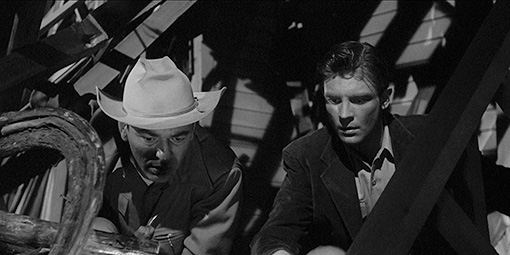
A few of the elements here were genre stalwarts even back in 1957, but are dealt with and moved on from at unusual speed. That the young and good-looking male and female leads are in love is no surprise (let's face it, if they weren't at the start then they would be by the end), but they're given precious little time to express it on screen. A warm greeting, a kiss and a reassuring word and they're back into action, their encounters never slowing the flow of the narrative for more than a few seconds. And boy does the narrative move, barrelling through a series of incidents, encounters and revelations with nary a pause for breath, the savvy economy of John Sherwood's direction keeping everything clear without ever letting us feel we've fallen face-down into an exposition soup.
But it's when the rocks grow into huge monolithic crystals that the film really delivers on the promise of its title. Growing skyward until toppled by the force of gravity, they crash down through farm holdings and shatter into thousands of smaller crystals that then also begin to grow, a cycle that looks set to repeat and expand until they reach the valley floor and lay waste to the town and everything beyond. It's a spectacularly realised vision, thanks to some excellent model work and over-cranking the camera by just the amount required to convince us of the monoliths' gargantuan size and weight as they fall.
The thing that sets these particular aliens apart from the genre norm is that there is no conscious intent, malicious or otherwise, on the invaders' part. Their arrival on the planet was accidental, and their growth, multiplication and effect on the human population is the result of a chemical reaction that is part of their organic makeup. In this respect, The Monolith Monsters is both a film of its time and one that looks forward to the pandemic themed works of more recent years, where humankind is threatened by a primal organism that is just doing what it has to do in order to survive and propagate. At one point the characters even speculate on how quickly and far the effect of the crystals will spread if unchecked, a favourite cornerstone of pandemic fiction.
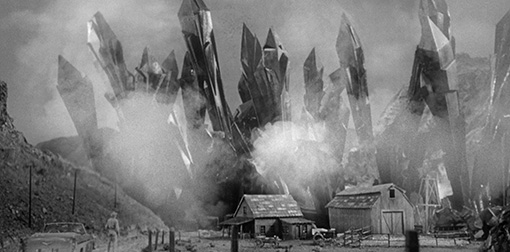
I'm still not sure why The Monolith Monsters has not attracted the same sort of critical attention as some other notable American science fiction films of the 50s, or why it's been so hard to track down over the years, at least in the UK. Certainly it lacks the subtextual clout that distinguishes the best of these films, but its central conceit, its pacing and its impressive production design and effects still put it on a par with its more widely seen contemporaries. The performances are all solid, but my favourite comes from an uncredited William Schallert as the wrapped-up-in-his-job weatherman that Dave calls for a rain forecast, providing a few moments of character humour in an otherwise straight-faced drama.
It's also worth noting that the ties with Jack Arnold go beyond his credit as the co-story writer. Director John Sherwood worked primarily as an assistant director and only helmed three films as director, the second of which was The Creature Walks Among Us and Return of the Creature, the follow-up films to Arnold's The Creature From the Black Lagoon. Leading man Grant Williams went on to star in Arnold's most celebrated film, The Incredible Shrinking Man, and the opening meteor crash is an alternative take of the shot used at the start of Arnold's It Came From Outer Space. And while it might be stretching it to suggest that Simpsons creator Matt Groening may be a fan just because a family named Simpson figure in the story, it's hard not to break into a knowing smile when the professor who comes to Dave's aid turns out to be called Flanders.
The Monolith Monsters on Blu-ray? I genuinely couldn't believe it when I first heard about it. And it's not just been slapped out with whatever print German distributor Anolis Entertainment could get their hands on, but properly restored. But I'll get to that after the aspect ratio issue.
Although The Monolith Monsters, as far as I know, has never been released on DVD in the UK, it did get an American DVD release back in 2008 from Universal as part of the 6-disc The Classic Sci-Fi Ultimate Collection. The aspect ratio there was 1.33:1, yet here the image has been cropped down to 2.0:1. So what's going on?
During the 1950s, the CinemaScope format was proving a hit with audiences and, inevitably perhaps, a number of rival processes appeared its wake. One of the few to make an impact was the more cost effective SuperScope. While CinemaScope was an anamorphic process (the scope image was squeezed up by the camera lens and unsqueezed by the projector), with SuperScope you shot you film in the regular Academy ratio of 1.33:1, then the image was cropped to 2.0:1 at the printing or projection stage. This did require cinematographers and camera operators to frame their shots accordingly, leaving plenty of space above the heads of the actors and making sure no important picture information was at the bottom of the screen, a process still in use today under the catch-all banner of Super-35.
Having said all that, as far as I know The Monolith Monsters was not shot in SuperScope, but like all the major studios, Universal were experimenting with a number of aspect ratios at the time, and word has it that this film was composed with both widescreen and open matte projection in mind. There are a few occasions when the 2.0:1 framing does feel a little tight by comparison to the 1.33 version, notably the opening credits (although nothing is clipped here), a 3-shot in which Ginny is cropped at the neck, and the wide shots of the giant crystals towering above the valley. But there is also a good deal of space above the heads of characters on the Academy famed print, more than would normally be compositionally ideal, and in this respect the 2.0:1 framing feels far more appropriate. Indeed, watching the 2.0:1 framed version without making direct comparisons, hardly ever did the image feel cropped or uncomfortably cramped. Some will doubtless complain, and I fully understand and even support their reasoning, but on the evidence here, 2.0:1 does feel as close to dammit as the correct projection ratio. To complicate matters further, there appears to be a little more picture information at the sides on the Blu-ray transfer.
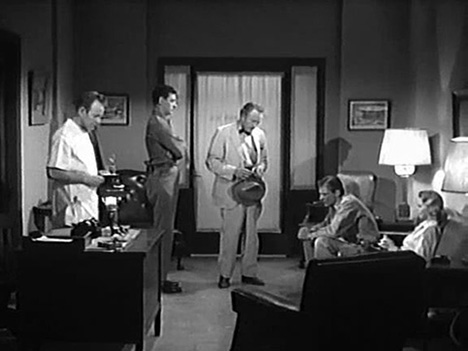
Compare the 1.33:1 framing on the DVD (above) with the 2.0:1 framing on the Blu-ray (below). Note also the extra picture information on the sides of the new transfer.
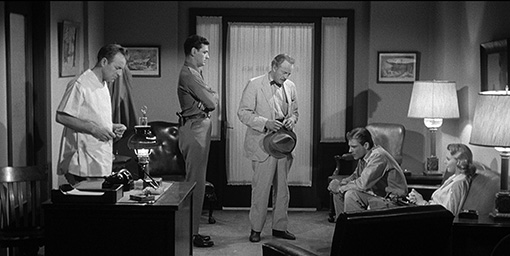
In all other respects the film looks better here than I ever imagined that it would. Created from an HD master provided by Universal Studios, the image is lovely in every respect, boasting a fine tonal range, nicely judged contrast with inky blacks, and a level of detail that leaves Universal's earlier DVD in the dust. There's never any doubt that you're watching a Blu-ray. The picture is also supremely clean, with hardly a dust spot to be seen and no trace of damage or frame instability. Fine film grain is visible and I could see no obvious signs of edge enhancement. There is some minor flickering, but this is never distracting.
The DTS-HD Master Audio 2.0 mono soundtrack is also in better shape than I was expecting. The dynamic range is inevitably not up to that of a modern day feature, but it's not half bad and even above average for a film of its age. The dialogue is always clear and the bass response is solid enough when the monoliths crash to earth to really kick off the subwoofer if you choose to engage it.
Inevitably there is also a German dub, which the disc defaults to, so you'll have to switch over if you want to watch in the original English. The crisper sound quality of the dialogue here suggests that this was added at a much later date, and no attempt has been made to sonically match it to the soundtrack of the film. Even if you weren't looking at the screen as it plays, you'd have no problem pegging this as a dub.
Optional German subtitles are available for the main feature.
Not a lot here, but still of interest are the American Trailer (2:02), which includes footage from the climax and assures us that this is "the most startling science fiction concept ever brought to the screen," and the German Trailer (2:02), which is essentially the same thing but with a sonically mismatched German dub. Both are framed 1.78:1.
American Advertising Advice (7:45) is a rolling gallery of material from the film's campaign booklet which the camera zooms into and scans for interesting detail, a technique I rather liked. I particularly enjoyed the little cartoon of a pile of rocks with a sign above them stating, "These stones seem harmless, but BEWARE of the rocks in Monolith Monsters. They could turn you into stone." Thanks for the warning.
Art Gallery (1:49) is a slide show of posters and promotional stills, not all of them American in origin. All are reproduced at a decent size, but they switch at a lick, so be ready with the pause button if you want to study any of them in detail.
It seems almost absurd that this often undervalued gem of 50s American science fiction cinema should be brought so vividly to life on a German Blu-ray, but then again why not? Such films always had a universal appeal (no studio pun intended), something I was made even more aware of when a friend who is a few years my senior revealed to me that it was one of her favourite films as a child in her native Japan. There may not be much in the way of extras, and some will have issues with the 2.0:1 aspect ratio, but in other respects Anolis Entertainment have done The Monolith Monsters proud. For fans of 50s science fiction cinema, enthusiastically recommended.
|